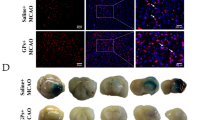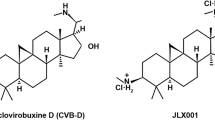Abstract
Chronic cerebral hypoperfusion (CCH) is the leading cause of chronic cerebral dysfunction syndrome with its complex pathological mechanisms involving cortical and hippocampal neuronal loss, white matter lesions, and neuroinflammation. I-C-F-6 is a septapeptide, which has anti-inflammatory and anti-fibrotic effects. This study aimed to evaluate the neuroprotective effect of I-C-F-6 in chronic cerebral hypoperfusion (CCH)-induced neurological injury. C57BL/6 J mice were subjected to bilateral common carotid artery stenosis (BCAS), and BV2 microglia cells were induced with oxygen-glucose deprivation (OGD). In vivo, mice were divided randomly into four groups: Sham, BCAS, GBE (30 mg/kg), and I-C-F-6 (0.5 mg/kg). In vitro, microglia were divided randomly into four groups: control, OGD, I-C-F-6 (25 μg/mL), and Shikonin (800 nmol/L). Through LFB, TUNEL, and NeuN staining, we found that I-C-F-6 was able to mitigate myelin pathology and reduce the number of apoptotic neurons. Furthermore, immunofluorescence staining revealed that I-C-F-6 was able to reduce microglia clustering and downregulate NF-κB p65. We also observed a significant downregulation of M1 phenotype microglia signature genes, such as TNF-α, iNOS, and upregulation of anti-inflammatory cytokines, such as Arg-1 and IL-10, indicating that I-C-F-6 may mainly reduce polarization towards the M1 phenotype in microglia. Notably, I-C-F-6 downregulated the expression of NF-κB signaling pathway-related proteins IKK-β and NF-κB p65, as well as pro-inflammatory cytokines IL-1β and iNOS. In conclusion, I-C-F-6 can improve neurological damage, alleviate neuroinflammation, and inhibit microglia polarization to the M1 phenotype via the NF-κB signaling pathway.





Similar content being viewed by others
Data availability
The datasets used and analyzed during the current study are available from the corresponding author on reasonable request.
Abbreviations
- WML:
-
White matter lesion
- BCAS:
-
Bilateral common carotid artery stenosis
- CCA:
-
Common carotid artery
- OGD:
-
Oxygen-glucose deprivation
- CCH:
-
Chronic cerebral hypoperfusion
- GBE:
-
Ginkgo biloba extract
- MAPK:
-
Mitogen-activated protein kinase
- NF-κB:
-
Nuclear factor kappa-B
- IL-1β:
-
Interleukin-1β
- TNF-α:
-
Tumor necrosis factor-α
- MMPs:
-
Metalloproteinases
- ROS:
-
Reactive oxygen species
- VCI:
-
Vascular cognitive impairment
- CSVD:
-
Cerebral small vascular disease
- CNS:
-
Central nervous system
References
Bang J, Jeon WK, Lee IS, Han JS, Kim BY (2013) Biphasic functional regulation in hippocampus of rat with chronic cerebral hypoperfusion induced by permanent occlusion of bilateral common carotid artery. PLoS ONE 8(7):e70093. https://doi.org/10.1371/journal.pone.0070093
Camandola S, Mattson MP (2017) Brain metabolism in health, aging, and neurodegeneration. EMBO J 36(11):1474–1492. https://doi.org/10.15252/embj.201695810
Cao WY, Lin JB, Xiang W, Liu JY, Wang BR, Liao WJ, Jiang T (2022) Physical exercise-induced astrocytic neuroprotection and cognitive improvement through primary cilia and mitogen-activated protein kinases pathway in rats with chronic cerebral hypoperfusion. Frontiers in Aging Neuroscience 14:866336. https://doi.org/10.3389/fnagi.2022.866336
Chen Y, Guo Z, Peng X, Xie W, Chen L, Tan Z (2018) Nimodipine represses AMPK phosphorylation and excessive autophagy after chronic cerebral hypoperfusion in rats. Brain Res Bull 140:88–96. https://doi.org/10.1016/j.brainresbull.2018.03.019
Cheng YY, Jope R, Beurel E (2016) Stress-induced neuroinflammation is mediated by GSK3-dependent TLR4 signaling that promotes susceptibility to depression-like behavior. Psychoneuroendocrinology 71:52–53. https://doi.org/10.1016/j.bbi.2015.12.012
Duncombe J, Kitamura A, Hase Y, Ihara M, Kalaria RN, Horsburgh K (2017) Chronic cerebral hypoperfusion: a key mechanism leading to vascular cognitive impairment and dementia. Closing the translational gap between rodent models and human vascular cognitive impairment and dementia. Clin Sci 131(19):2451–2468. https://doi.org/10.1042/cs20160727
Fantini S, Sassaroli A, Tgavalekos KT, Kornbluth J (2016) Cerebral blood flow and autoregulation: current measurement techniques and prospects for noninvasive optical methods. Neurophotonics 3(3):031411. https://doi.org/10.1117/1.nph.3.3.031411
Farkas E, Luiten PG, Bari F (2007) Permanent, bilateral common carotid artery occlusion in the rat: a model for chronic cerebral hypoperfusion-related neurodegenerative diseases. Brain Res Rev 54(1):162–180. https://doi.org/10.1016/j.brainresrev.2007.01.003
Galleguillos D, Wang Q, Steinberg N, Zaidi A, Shrivastava G, Dhami K, Daskhan GC, Schmidt EN, Dworsky-Fried Z, Giuliani F, Churchward M, Power C, Todd K, Taylor A, Macauley MS, Sipione S (2022) Anti-inflammatory role of GM1 and other gangliosides on microglia. J Neuroinflammation 19(1):9. https://doi.org/10.1186/s12974-021-02374-x
Godbout JP, Chen J, Abraham J, Richwine AF, Berg BM, Kelley KW, Johnson RW (2005) Exaggerated neuroinflammation and sickness behavior in aged mice following activation of the peripheral innate immune system. FASEB J 19(10):1329–1331. https://doi.org/10.1096/fj.05-3776fje
Han QY, Zhang H, Zhang X, He DS, Wang SW, Cao X, Dai YT, Xu Y, Han LJ (2019) dl-3-n-butylphthalide preserves white matter integrity and alleviates cognitive impairment in mice with chronic cerebral hypoperfusion. CNS Neurosci Ther 25(9):1042–1053. https://doi.org/10.1111/cns.13189
Huang XB, Chen YJ, Chen WQ, Wang NQ, Wu XL, Liu Y (2018) Neuroprotective effects of tenuigenin on neurobehavior, oxidative stress, and tau hyperphosphorylation induced by intracerebroventricular streptozotocin in rats. Brain Circ 4(1):24–32. https://doi.org/10.4103/bc.bc_2_17
Jha MK, Lee WH, Suk K (2016) Functional polarization of neuroglia: Implications in neuroinflammation and neurological disorders. Biochem Pharmacol 103:1–16. https://doi.org/10.1016/j.bcp.2015.11.003
Jiang T, Luo J, Pan XN, Zheng HQ, Yang HC, Zhang LY, Hu XQ (2021) Physical exercise modulates the astrocytes polarization, promotes myelin debris clearance and remyelination in chronic cerebral hypoperfusion rats. Life Sci 278:119526. https://doi.org/10.1016/j.lfs.2021.119526
Kettenmann H, Hanisch UK, Noda M, Verkhratsky A (2011) Physiology of microglia. Physiol Rev 91(2):461–553. https://doi.org/10.1152/physrev.00011.2010
Khan MB, Alam H, Siddiqui S, Shaikh MF, Sharma A, Rehman A, Baban B, Arbab AS, Hess DC (2023) Exercise improves cerebral blood flow and functional outcomes in an experimental mouse model of vascular cognitive impairment and dementia (VCID). Transl Stroke Res. https://doi.org/10.1007/s12975-023-01124-w
Kim MS, Bang JH, Lee J, Han JS, Baik TG, Jeon WK (2016) Ginkgo biloba L. extract protects against chronic cerebral hypoperfusion by modulating neuroinflammation and the cholinergic system. Phytomedicine 23(12):1356–1364
Kitagawa K, Yagita Y, Sasaki T, Sugiura S, Omura-Matsuoka E, Mabuchi T, Matsushita K, Hori M (2005) Chronic mild reduction of cerebral perfusion pressure induces ischemic tolerance in focal cerebral ischemia. Stroke 36(10):2270–2274. https://doi.org/10.1161/01.str.0000181075.77897.0e
Lee KM, Bang J, Kim BY, Lee IS, Han JS, Hwang BY, Jeon WK (2015) Fructus mume alleviates chronic cerebral hypoperfusion-induced white matter and hippocampal damage via inhibition of inflammation and downregulation of TLR4 and p38 MAPK signaling. BMC Complement Altern Med 15:125. https://doi.org/10.1186/s12906-015-0652-1
Leng FD, Edison P (2021) Neuroinflammation and microglial activation in Alzheimer disease: where do we go from here? Nat Rev Neurol 17(3):157–172. https://doi.org/10.1038/s41582-020-00435-y
Li Y, Du XF, Liu CS, Wen ZL, Du JL (2012) Reciprocal regulation between resting microglial dynamics and neuronal activity in vivo. Dev Cell 23(6):1189–1202. https://doi.org/10.1016/j.devcel.2012.10.027
Mi-Na W, Shi-Xun XU, Jin-Xuan L, Li-Wei R, L. Hai-Min L, Yu-Zhong Z (2015) Experimental study on the effect of oligo-peptide IC-F-6 in Carapax Trionycis against chronic alcoholic liver injury in mice. Tianjin Journal of Traditional Chinese Medicine
Miyanohara J, Kakae M, Nagayasu K, Nakagawa T, Mori Y, Arai K, Shirakawa H, Kaneko S (2018) TRPM2 channel aggravates CNS inflammation and cognitive impairment via activation of microglia in chronic cerebral hypoperfusion. J Neurosci 38(14):3520–3533. https://doi.org/10.1523/jneurosci.2451-17.2018
Mosser DM, Edwards JP (2008) Exploring the full spectrum of macrophage activation. Nat Rev Immunol 8(12):958–969. https://doi.org/10.1038/nri2448
Subhramanyam CS, Wang C, Hu Q, Dheen ST (2019) Microglia-mediated neuroinflammation in neurodegenerative diseases. Semin Cell Dev Biol 94:112–120. https://doi.org/10.1016/j.semcdb.2019.05.004
Sun HT, Chen GX, Wen B, Sun JL, An HY, Pang J, Xu W, Yang XM, He SQ (2018) Oligo-peptide I-C-F-6 inhibits hepatic stellate cell activation and ameliorates CCl4-induced liver fibrosis by suppressing NF-kappa B signaling and Wnt/beta-catenin signaling. J Pharmacol Sci 136(3):133–141. https://doi.org/10.1016/j.jphs.2018.01.003
Sun Z, Gao C, Gao D, Sun R, Li W, Wang F, Wang Y, Cao H, Zhou G, Zhang J, Shang J (2021) Reduction in pericyte coverage leads to blood-brain barrier dysfunction via endothelial transcytosis following chronic cerebral hypoperfusion. Fluids Barriers CNS 18(1):21. https://doi.org/10.1186/s12987-021-00255-2
Sweeney MD, Kisler K, Montagne A, Toga AW, Zlokovic BV (2018) The role of brain vasculature in neurodegenerative disorders. Nat Neurosci 21(10):1318–1331. https://doi.org/10.1038/s41593-018-0234-x
Volgyi K, Gulyassy P, Todorov MI, Puska G, Badics K, Hlatky D, Kekesi KA, Nyitrai G, Czurko A, Drahos L, Dobolyi A (2018) Chronic cerebral hypoperfusion induced synaptic proteome changes in the rat cerebral cortex. Mol Neurobiol 55(5):4253–4266. https://doi.org/10.1007/s12035-017-0641-0
Wake H, Moorhouse AJ, Jinno S, Kohsaka S, Nabekura J (2009) Resting microglia directly monitor the functional state of synapses in vivo and determine the fate of ischemic terminals. J Neurosci 29(13):3974–3980. https://doi.org/10.1523/jneurosci.4363-08.2009
Wang M, Qin C, Luo X, Wang J, Wang X, Xie M, Hu J, Cao J, Hu T, Goldman SA, Nedergaard M, Wang W (2019) Astrocytic connexin 43 potentiates myelin injury in ischemic white matter disease. Theranostics 9(15):4474–4493. https://doi.org/10.7150/thno.31942
Wang Y, Jia X, Guo Z, Li L, Liu T, Zhang P, Liu H (2022) Effect of dietary soybean saponin Bb on the growth performance, intestinal nutrient absorption, morphology, microbiota, and immune response in juvenile Chinese soft-shelled turtle (Pelodiscus sinensis). Front Immunol 13:1093567. https://doi.org/10.3389/fimmu.2022.1093567
Wohleb ES, Terwilliger R, Duman CH, Duman RS (2018) Stress-induced neuronal colony stimulating factor 1 provokes microglia-mediated neuronal remodeling and depressive-like behavior. Biol Psychiatry 83(1):38–49. https://doi.org/10.1016/j.biopsych.2017.05.026
Wu B, Liu M, Liu H, Li W, Tan S, Zhang S, Fang Y (2007) Meta-analysis of traditional Chinese patent medicine for ischemic stroke. Stroke 38(6):1973–1979. https://doi.org/10.1161/strokeaha.106.473165
Yan N, Xu Z, Qu C, Zhang J (2021) Dimethyl fumarate improves cognitive deficits in chronic cerebral hypoperfusion rats by alleviating inflammation, oxidative stress, and ferroptosis via NRF2/ARE/NF-kappaB signal pathway. Int Immunopharmacol 98:107844. https://doi.org/10.1016/j.intimp.2021.107844
Yan Y, Furumura M, Gouya T, Iwanaga A, Teye K, Numata S, Karashima T, Li XG, Hashimoto T (2015) Shikonin promotes skin cell proliferation and inhibits nuclear factor-kappaB translocation via proteasome inhibition in vitro. Chin Med J (engl) 128(16):2228–2233. https://doi.org/10.4103/0366-6999.162512
Zhang LY, Pan J, Mamtilahun M, Zhu Y, Wang L, Venkatesh A, Shi R, Tu X, Jin K, Wang Y, Zhang Z, Yang GY (2020) Microglia exacerbate white matter injury via complement C3/C3aR pathway after hypoperfusion. Theranostics 10(1):74–90. https://doi.org/10.7150/thno.35841
Zhang S, Wang J, Zhao H, Luo Y (2018) Effects of three flavonoids from an ancient traditional Chinese medicine Radix puerariae on geriatric diseases. Brain Circ 4(4):174–184. https://doi.org/10.4103/bc.bc_13_18
Funding
This work was supported by the grants from National key R&D program for the key research project of modernization of traditional Chinese medicine (2019YFC1711602).
Author information
Authors and Affiliations
Contributions
S.D. and Y.G. carried out this study. M.L., X.L., Y.M., and Y.G. drafted the manuscript text and prepared the figures. Y.Z. and T.L. conceived the project, interpreted the data, and revised and finalized the manuscript. M.L. and X.L. constructed the animal model. Y.M. and Y.G. revised the manuscript. All authors read and approved the final manuscript. The authors declare that all data were generated in-house and that no paper mill was used.
Corresponding authors
Ethics declarations
Competing interests
The authors declare no competing interests.
Ethical statement
All animal experiments and surgical procedures were overseen by the Institutional Animal Care and Use Committee at Shanghai University and followed international guidelines for ethical use of experimental animals (No. ECSHU 2023-009).
Additional information
Publisher's Note
Springer Nature remains neutral with regard to jurisdictional claims in published maps and institutional affiliations.
Rights and permissions
Springer Nature or its licensor (e.g. a society or other partner) holds exclusive rights to this article under a publishing agreement with the author(s) or other rightsholder(s); author self-archiving of the accepted manuscript version of this article is solely governed by the terms of such publishing agreement and applicable law.
About this article
Cite this article
Deng, S., Gao, Y., Lv, M. et al. I-C-F-6 attenuates chronic cerebral hypoperfusion-induced neurological injury in mice by modulating microglia polarization. Naunyn-Schmiedeberg's Arch Pharmacol 397, 3917–3928 (2024). https://doi.org/10.1007/s00210-023-02783-0
Received:
Accepted:
Published:
Issue Date:
DOI: https://doi.org/10.1007/s00210-023-02783-0




